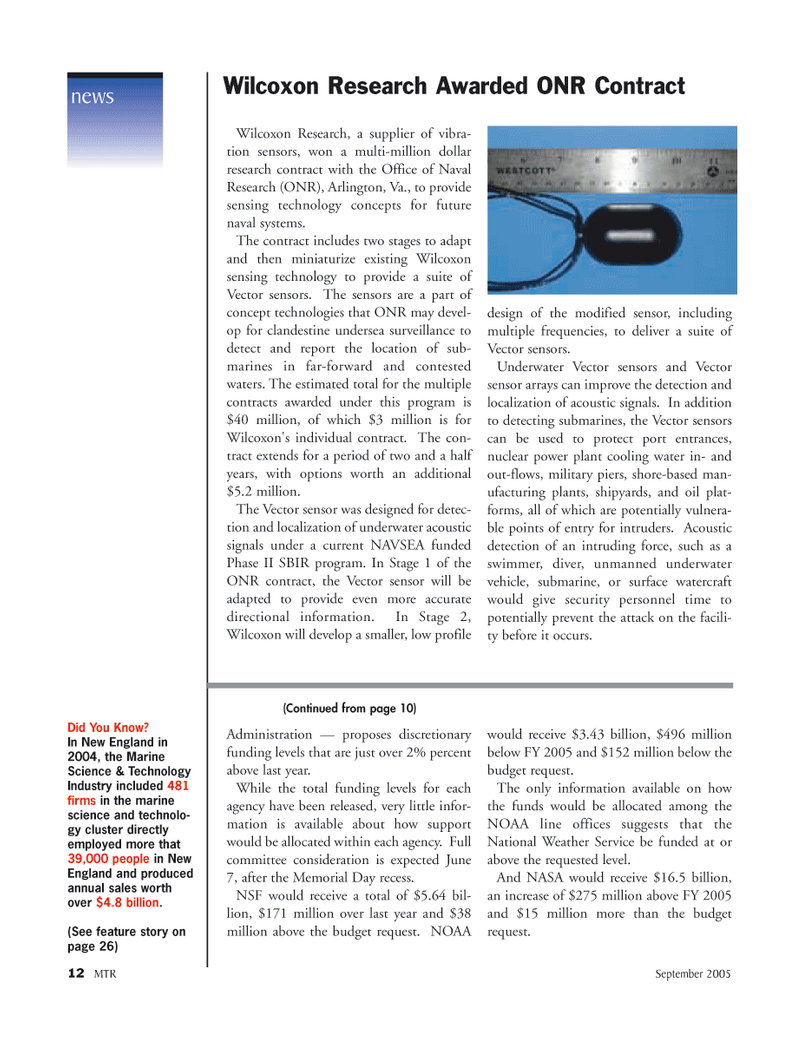
Page 12: of Marine Technology Magazine (September 2005)
Maritime Security & Undersea Defense
Read this page in Pdf, Flash or Html5 edition of September 2005 Marine Technology Magazine
12 MTR September 2005
Wilcoxon Research Awarded ONR Contract
Administration — proposes discretionary funding levels that are just over 2% percent above last year.
While the total funding levels for each agency have been released, very little infor- mation is available about how support would be allocated within each agency. Full committee consideration is expected June 7, after the Memorial Day recess.
NSF would receive a total of $5.64 bil- lion, $171 million over last year and $38 million above the budget request. NOAA would receive $3.43 billion, $496 million below FY 2005 and $152 million below the budget request.
The only information available on how the funds would be allocated among the
NOAA line offices suggests that the
National Weather Service be funded at or above the requested level.
And NASA would receive $16.5 billion, an increase of $275 million above FY 2005 and $15 million more than the budget request. news
Wilcoxon Research, a supplier of vibra- tion sensors, won a multi-million dollar research contract with the Office of Naval
Research (ONR), Arlington, Va., to provide sensing technology concepts for future naval systems.
The contract includes two stages to adapt and then miniaturize existing Wilcoxon sensing technology to provide a suite of
Vector sensors. The sensors are a part of concept technologies that ONR may devel- op for clandestine undersea surveillance to detect and report the location of sub- marines in far-forward and contested waters. The estimated total for the multiple contracts awarded under this program is $40 million, of which $3 million is for
Wilcoxon's individual contract. The con- tract extends for a period of two and a half years, with options worth an additional $5.2 million.
The Vector sensor was designed for detec- tion and localization of underwater acoustic signals under a current NAVSEA funded
Phase II SBIR program. In Stage 1 of the
ONR contract, the Vector sensor will be adapted to provide even more accurate directional information. In Stage 2,
Wilcoxon will develop a smaller, low profile design of the modified sensor, including multiple frequencies, to deliver a suite of
Vector sensors.
Underwater Vector sensors and Vector sensor arrays can improve the detection and localization of acoustic signals. In addition to detecting submarines, the Vector sensors can be used to protect port entrances, nuclear power plant cooling water in- and out-flows, military piers, shore-based man- ufacturing plants, shipyards, and oil plat- forms, all of which are potentially vulnera- ble points of entry for intruders. Acoustic detection of an intruding force, such as a swimmer, diver, unmanned underwater vehicle, submarine, or surface watercraft would give security personnel time to potentially prevent the attack on the facili- ty before it occurs.
Did You Know?
In New England in 2004, the Marine
Science & Technology
Industry included 481 firms in the marine science and technolo- gy cluster directly employed more that 39,000 people in New
England and produced annual sales worth over $4.8 billion. (See feature story on page 26) (Continued from page 10)
MTR#2 (1-16).qxd 8/30/2005 4:47 PM Page 14

 11
11

 13
13
